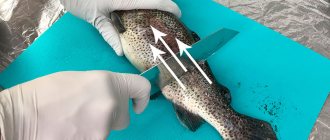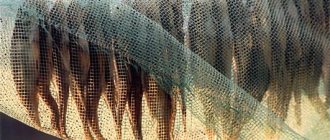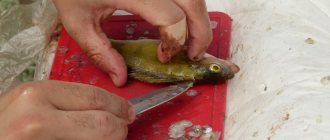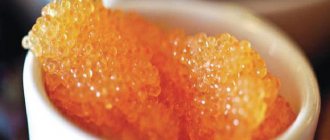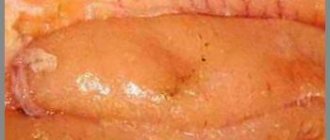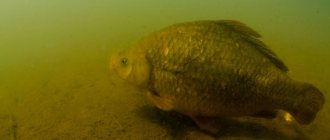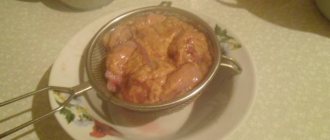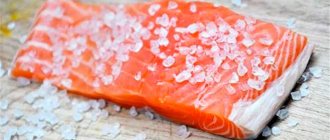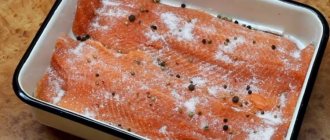Before you cook perch
Before purchasing, carefully inspect the perches for freshness. Signs of quality fish:
- the skin is elastic and without blemishes; after pressing, a dimple is formed, which should recover in 2-3 seconds;
- eyes – bulging and transparent;
- gills - red or pink (the presence of mucus and plaque is not allowed);
- fins – well normal size (underdeveloped fins, a sign of fish raised in unnatural conditions);
- the simplest method for determining quality - fresh fish does not drown;
It is advisable to choose fish of the same weight. It is not necessary to remove the entrails; this will not affect the taste of the product.
How to pickle perch for drying
» Recipes » How to dry perch at home at any time of the year
How to dry perch is a popular question that fishing enthusiasts have repeatedly asked. Besides the fact that perch is fried and baked, it makes an excellent beer snack. Its main advantage is that it is prepared from fresh product caught the day before. By performing all the processes correctly, you will get a delicious battering ram.
In the summer, there are no problems with a place to dry the ram (balcony), which cannot be said about the cold season. The problem is solved by constructing a homemade dryer over a stove or in a warm, ventilated room. Knowing where and how to dry perches in winter, you should familiarize yourself with the required ingredients:
- 1.5 kilograms of perches;
- 300 grams of salt;
- 3 tablespoons sugar.
Perch drying process
The process of preparing dried fish involves 4 main stages:
- PREPARATION. The fish is washed with running water. The large one is cleaned of its entrails, the small one is not cleaned.
- SALTED. Lasts 2–4 days (the size of the catch is taken into account). Salt and sugar are mixed. The resulting mixture is generously sprinkled on the first layer of the catch, placed in a prepared deep container. Place the second one on top, sprinkle with salt and sugar. The entire prepared volume of river fish is salted. The catch is covered with a plate with a diameter smaller than that of the main container. A weight (a container of water) is placed on the plate. If the back of the salted perch is elastic when pressed, it’s time to move on to soaking.
- SOAKING. The duration is similar to the previous stage. The salted product is filled with water. During soaking, the liquid is changed several times. There is a third stage to get rid of excess salt. Knowing the basics of proper catch preparation and how to properly dry perch, your supply of excellent snacks will be replenished.
- DRYING. How to dry perch, where it is best to do it, was discussed above. Having strung the fish on a wire, you should know how long to dry the perch. The recommended time is a week. You can try the snack earlier. Instead of a dried delicacy, you will get a dried one.
Having caught a rich catch of river fish, you don’t need to worry about the lack of ideas for preparing it. If fried or steamed dishes are no longer impressive, you should try the given recipe. Knowing how to dry perch at home, you will have a tasty ram with a long shelf life in your house.
In the Russian expanses you can find lake and river perch; these freshwater inhabitants have shell-like scales, but boast tender, non-greasy, pleasant white meat. Fish fillets are baked, fried, boiled in fish soup, salted and smoked; perch meat contains a lot of useful substances.
It is not difficult to understand how to salt perch at home. Sea bass is more predatory, but is also rich in microelements. It is good to drink foamy drinks with salted perch or hot smoked fish.
The fish will last a long time if you salt it. For 10 kilos of perch you will need a kilo of salt and a bucket of water.
To salt the fish, they are prepared. Carefully remove the scales from the perches using a knife on a cutting board. The abdomen of each carcass is cut lengthwise, starting at the head, ending at the sub-caudal fin. The gallbladder and liver are removed. Next, you should start removing the gills and the first dorsal fin.
Tip: The fish on salted crystals are placed tightly in rows, the head of one should be adjacent to the tail of the other, as well as the back to the belly.
All rows of perches are generously sprinkled with salt. A layer of salt on top should literally cover all the carcasses. You should press down the fish with a board with pressure. How long the carcasses will be salted in a cool place depends on the size of the fish; on average, the period lasts from 2 to 5 days.
Salted perch is good for drying. Before drying, you need to soak the carcasses in water for about 4 or 5 hours, after which the tasty delicacy can be consumed.
If you salt the perch in a warm place, you will need more salt, about 25 percent. In this case, the ambassador will last less time.
To salt perches, use coarse salt. It is needed mainly to remove moisture from the fish.
Damage to the gallbladder is unacceptable; when it is cut or ruptured, every part of the fish that has been exposed to bile is cut out or immediately rubbed with plenty of salt.
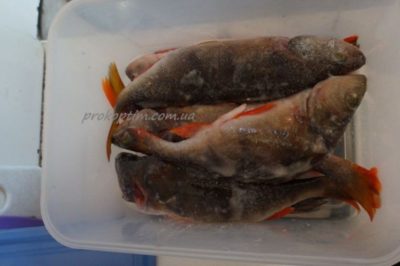
Excessively salted fish are soaked in cold water; you can use milk that has cooled in the refrigerator for this purpose. The soaked products are filled with marinade liquid.
To ensure that the scales of the perch are cleaned well, the fish should be immersed in boiling water for a couple of seconds. To obtain the original taste of the product, granulated sugar is added to the salt during the salting process.
It is best to use carcasses of approximately the same weight when salting. One-kilogram perches are not always gutted if desired. Fish is not washed before salting. The husks are also removed at discretion. If you are going to gut it, you need to wipe the belly from the inside using paper napkins or a clean cloth.
Many people will appreciate the product of hot smoked or dried perch with beer. To dry or before smoking, you will need to purchase a fresh product and salt it. It is better to choose medium-sized fish, the weight can be from 100 grams to half a kilo. The carcasses are washed under streams of ice water. You can gut it, or you can leave the fish whole.
In an enamel or plastic container, you need to cover a three-millimeter layer of salt, and the perches will be placed tightly and in layers on top. Each row should be sprinkled with salt crystals. The bottom and last layers are sprinkled more heavily than the middle ones. The product is covered with a plate, or for this purpose a lid with a smaller diameter than the container is taken. On top you will need a weight weighing no more than 2 kilos.
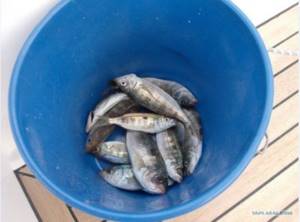
Salted fish should be kept in the dark and cold. The ideal place would be a refrigerator. When the third day has passed, the perch is rinsed to remove salt, mucus and particles of seasonings, if any have been used.
Stringed carcasses are hung in ventilated places, for example, on a balcony, in a garden or on a personal plot. The weather must be warm and dry, otherwise the product will not dry deliciously. The process lasts from 5 to 8 days.
To dry faster, in 2 or 3 days, you can hang the fish at the top of the gas stove so that the distance between it and the product is about 80 cm. The finished perch is wrapped in cellophane and put on the refrigerator shelf; storage time is not limited.
The freezer is contraindicated for dried carcasses.
Smoked fish
Hot smoked fish is perfect for a picnic instead of barbecue. To smoke sea bass or river bass, the product is taken to a smokehouse. But first, raw carcasses need to be salted. To smoke 3 kilos of fish per batch, salt is needed in large quantities.
Cleaning perch for hot smoking involves gutting, but the heads and scales are not removed. The fish is washed before the process. The carcasses are generously rubbed with salt crystals; the inside of the bellies must also be salted. Wait 4 hours, rinse the product in clean cool water and begin to smoke. The wood chips should evenly cover the bottom of the smokehouse. Hot smoked fish on grills is incredibly tasty.
For drying, purchase fresh perch of medium size and weighing from 100 to 500 g. First of all, thoroughly rinse the fish under cold water and gut it (if desired).
Then take an enamel or plastic dish (in no case metal), cover its bottom with a 3-mm layer of salt and lay the perches in dense layers, trying to maintain a certain order - tummy to tummy, head to tail.
Sprinkle the first layer of fish generously with salt and add the next row. Cover the last layer of perches completely with salt and cover the fish with a lid, the size of which is slightly smaller than the diameter of the dish.
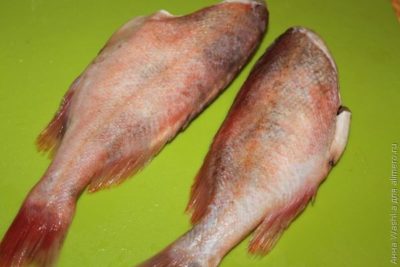
Place a weight on the lid, the weight of which does not exceed 2 kg, and place the dish with the perches placed in it in a dark and cold place, for example, on the bottom shelf of the refrigerator.
There the fish will be salted for three days, after which remove it from the salt and rinse thoroughly under cold running water to remove any remaining salt, spices and mucus.
To obtain lightly salted perch, rinse them for 10-15 minutes, then leave the fish for a while to drain the water. Then pat the snappers dry with a paper towel and begin the drying process.
Drying perches
To dry fish, take a rope, ordinary paper clips or hooks, made yourself from elastic steel wire, cut into small pieces and bent in a Z shape.
The best way to hang perch to dry is by threading hooks or string through the eye or lower lip - this will allow the internal fat to remain in the fish and make the meat more tender. Hang the strung perches for drying in any place that is well ventilated - in a city apartment such a place could be a balcony, and in a country house a garden or forest.
We suggest you familiarize yourself with: Do-it-yourself boat motor
Remember that you can dry perch outside in warm and dry weather, since fish soaked in moisture and frozen will not turn out dried and tasty.
Typically, perch is dried in 5-8 days, but if necessary, this process can be accelerated by hanging the fish over a gas stove, while maintaining a height of at least 80 cm from its surface. If you hang the perches a little lower, they can simply cook, and the uneviscerated fish will also acquire an unpleasant taste/smell due to the heated insides.
How to salt sea bass before smoking?
It is worth noting that salted sea bass is not as popular as smoked sea bass. Before smoking, the fish also needs to be pre-salted, but unlike the first method, here the fish is not cleaned of scales, but only gutted and thoroughly wiped so that there are no blood clots left in the abdomen, because they can spoil the smell and taste of the finished fish.
Salt should be taken in an amount of 10% of the weight of the fish. Rub each carcass with salt inside and out and place under pressure in a cool place. Before smoking sea bass, it is enough to salt it for 15 hours, then hang the fish to dry for about 9 hours. It is important that the fish is well dried, otherwise it may become moldy when cooked. When the fish is dry, it is ready for smoking.
Smoked and salted sea bass will become an original appetizer on your table.
It happens that in the hot season it is urgent to preserve fish. The best way to preserve for future use while fishing or at home is salting. How to properly salt river fish? Let's look at several recipes for preparing roach, perch, gobies, bleak and roach of large, medium and small sizes.
Preparing fish for salting
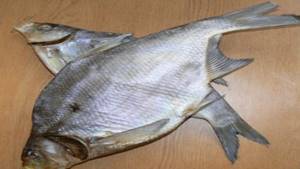
For salting, it is best to choose carcasses of approximately the same size. The ideal weight of perch for salting is up to 500 grams. It is not at all necessary to clean a small fish of husks and entrails - just rinse it under running cold water and remove the gills.
If the fish weighs more than a kilogram, then it is advisable to clean and gut it:
- place the fish on a kitchen board and remove the scales from it;
- Using a sharp knife, make a longitudinal incision through the entire belly, remove the intestines, liver, gall bladder, caviar and milt;
- remove the gills, as well as the first dorsal fin;
- Using a clean, dry cloth or multi-layer paper napkin, thoroughly blot the fish, paying special attention to the intra-abdominal cavity.
It is not necessary to remove the scales for salting. But if there is a need to do this, there are three simple methods:
- Scald with boiling water - the scales are removed much easier, the skin remains undamaged;
- Remove the scales along with the skin - cut the fish along the ridge and remove the dorsal fin, grab the edge of the skin and carefully cut it off the fish with a knife;
- For this method, the perch must first be frozen:
3.1. Using a knife, cut off the skin from the ridge and belly along with the fins;
3.2. Remove the tail fin;
3.3. Use a knife to pick up the skin from the side of the tail and remove it;
Smoked fish
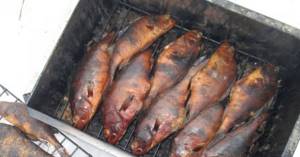
Hot smoked fish is perfect for a picnic instead of barbecue. To smoke sea bass or river bass, the product is taken to a smokehouse. But first, raw carcasses need to be salted. To smoke 3 kilos of fish per batch, salt is needed in large quantities.
Cleaning perch for hot smoking involves gutting, but the heads and scales are not removed. The fish is washed before the process. The carcasses are generously rubbed with salt crystals; the inside of the bellies must also be salted. Wait 4 hours, rinse the product in clean cool water and begin to smoke. The wood chips should evenly cover the bottom of the smokehouse. Hot smoked fish on grills is incredibly tasty.
Salting perches
Before you start salting perch, we recommend that you first read the article: “How to salt fish yourself?”, in which you will learn the differences between salting large and small fish, and also find popular recipes.
Types of pickling
1. Dry salting is the most suitable method for salting large fish. The utensil for such salting can be a wooden box or a basket made of wicker. A piece of cloth is placed at the bottom of this container. The fish is rubbed with salt on the inside and arranged in rows so that the carcasses lie belly up, tails to heads.
If the fish selected for salting are of different sizes, then they try to place the larger specimens in the lower rows - and the smaller ones are laid out on top. The last row is generously sprinkled with coarse (in no case iodized) salt, and then pressed down with something flat (like plywood) and weighed down with pressure.
2. Wet salting - a layer of salt is poured onto the bottom of any container that is incapable of oxidation. Next, the fish is laid out in rows - belly to back, head to tail. Each row is sprinkled with salt. The last layer is salt, which should completely cover the top fish. Next, everything is covered with a lid or a wooden circle and pressed down with pressure.
Then the container with the fish is placed in the refrigerator or cellar. Already on the second day, brine will begin to separate. Perches should stay in it from three days to a week. The main sign of a finished fish is somewhat hardened, dense meat, as well as a characteristic crunch of the ridge, which can be heard if you lightly pull the carcass by the tail or head. You should know that a cloudy brine with a reddish tint indicates that the product is beginning to deteriorate.
3. Spicy salting - differs from the wet method in that spices and herbs are laid between the rows of fish.
4. Sagging salting – provides a rather interesting taste of fish and a more delicate structure. At the same time, it takes time to build a special structure. How to salt perch using the sagging method? The work steps look like this:
- install a container for salting and place crossbars of the same length above it, which are necessary for hanging the fish;
- hang the prepared carcasses over the container, trying to keep them at some distance from each other;
- pour brine into containers, dissolving salt in water. The required amount of the latter is determined in this way: raw potatoes are dipped into salt water. If it completely floats to the surface, then the concentration of the solution is correct;
- The brine should completely cover the perches.
How long does it take to salt perch using the sagging method? Small fish will be ready in just five days, but large fish will require at least a week to thoroughly salt.
Salting recipes
How to soak carcasses after salting
In order to properly rinse and soak perches, you should know the following.
The fish is soaked only in cold water. If it was highly saline, then the water must be changed periodically.
The time for washing is determined as follows: for every 24 hours of salting, it is necessary to keep the carcasses in water for 1 hour. However, there is one exception. If the salting took place in brine, then the time is reduced to 40 - 50 minutes for every day.
It is necessary to monitor the condition of the carcasses and not let them get wet. Otherwise the meat will become too loose.
Before placing half of the finished dish in water, you should rinse the carcasses to remove mucus formed from water and spices.

Fishermen usually soak medium-sized river perch in cold water for about 3 hours
How to dry river perch
The process of drying perch is similar to the method of preparing dried fish. We have already described general recommendations for drying fish in the article “How to dry fish at home,” in which you will find recipes and tips for drying any fish.
The differences lie in the time required to obtain the dried product and the method of hanging the fish:
- the drying procedure takes from five to eight days;
- for this cooking method, fattier specimens are chosen;
- It is better to hang carcasses head up - this promotes uniform distribution of internal fat;
A richer taste appears if, after drying, the product is kept for one to two weeks.
- How to dry river perch
- Recipe for curing sea bass
Dried fish is a traditional Russian dish. In Russia, it is customary to dry both sea and river fish, and a variety of species are used for this.
The process involves pre-salting the fish, followed by soaking and drying it under natural or artificial conditions.
As a result of dehydration and further ripening, it acquires a special taste and smell, as well as a certain consistency due to compaction of the pulp. Its dried meat takes on an amber hue and becomes translucent.
Despite its apparent simplicity, this is not an easy task, and it takes a lot of time. A novice fisherman, in order not to spoil his catch, needs to pay attention to many nuances. The best quality is obtained from fish that was salted on the day of catch.
One of the popular types of fish used for drying and drying is perch.
River perch turns out to be somewhat dry, with a specific taste. As experienced fishermen say, it is fattier and tastier before spawning, that is, caught in winter or early spring. In the warm season, it is better to dry perch in the spring, before the heat sets in, or closer to autumn, when there are no flies. In the summer heat, the salting and soaking time will be long, and much more salt will be needed. There is a great risk that rotting will begin under the scales quickly seized by salt.
Preparation
For drying, it is advisable to take perches of approximately the same weight, since the salting period for small and large specimens is different. Ideally, these should be fish weighing 200-300 grams. In the warm season, 300 grams of coarse salt per kilogram of fish is needed; in winter it will be needed 2-3 times less.
The material of the dishes in which salting will take place should not oxidize. This can be enameled, glass or plastic containers (bucket, basin, pan), as well as boxes and baskets
In summer and in the spring-autumn period, the fish must be gutted, otherwise, if you leave the guts, you can ruin the entire salting. The gills are also removed, but the scales must be left behind. The perches are washed to remove mucus in cold water and then gutted.
Cut fish is not washed. To make the fish tastier, the belly can be left uncut, and the entrails removed through a cut near the ridge. Some fishermen remove dirt with a rag, believing that washing spoils the taste.
In winter, do not gut small fish, as this will make them fatter.
Pickling
Salting can be done dry or wet. Dry is more suitable for larger specimens. A box or basket is used as a container, with a piece of fabric placed at the bottom. The inside of the carcasses is rubbed with salt, then they are placed tightly in a box with their bellies up, tails to the head.
Sprinkle salt on top, place plywood or something flat and press down with pressure, for example, a stone, to remove air from bubbles and compact the meat. The released liquid will flow through the cracks in the box or basket. The salting time lasts from 5 to 10 days.
If you dry salt a small fish, you don’t have to remove the insides: they place it in a box on a rag, sprinkle it generously with salt, cover it with the other end of the rag and put pressure on top.
For salting, you need coarse, non-iodized salt and suitable containers. If the fish are different sizes, the larger ones are placed on the bottom of the dish, the small ones - on top.
We suggest you read: How to Catch Perch Using a Wobbler
You can optionally place bay leaves and spices between the rows. Cover it in a circle and put pressure so that it crushes the fish. Place in a cool place (refrigerator or cellar) so that the meat, which has not reached the salt, does not spoil. After salting, a brine begins to form, and in about two days it will cover all the fish.
The resulting brine should be transparent. If it is cloudy and reddish, the fish has begun to spoil. Salting time will take approximately 3 to 7 days, depending on the size of the fish. The finished perch has hardened meat; if you pull the tail or head, you should hear a crunch, as if the back is being pulled towards the ridge.
If these signs are not present, you need to keep the fish in brine for another day.
Flushing
After salting, soaking in cold water is necessary. Dried perch should not be too salty, with amber-colored meat. The duration of rinsing depends on the duration of salting. There is a rule: for every day of salting, there is an hour of soaking.
The perches are placed in a container with a large amount of cold water and washed by hand, the scales should not fly off. Then leave for several hours. It is important not to keep the fish in the water too long, otherwise its outer layers will become soggy.
You can try the perch for its salinity level.
Some recommend rinsing the perch under cold running water for 10 minutes to remove any mucus, remaining salt and spices. For lovers of lightly salted fish, the washing time can be slightly increased.
When the washing is completed, the water is allowed to drain, and the perches are placed in a well-ventilated place, but without sun, in a suspended form. Ideal drying conditions are outside at a temperature of 18-20⁰C. It is recommended to thread the fishing line through the eye or lower lip to preserve the internal fat in the fish and thus make it more tasty.
Instead of fishing line, you can use homemade hooks made from steel wire, cut and bent in the shape of the letter Z, or regular paper clips. To help the fish dry faster, you can insert toothpicks into the bellies.
Drying time depends on the size of the carcasses, the weather and who prefers what kind of fish - very dry or medium dried
To speed up the process, you can hang the perches above the gas stove, but lower than 80 cm from its surface. In this case, the fish will dry out in three days. You can dry perch in a well-ventilated attic or balcony, as well as in a cellar. In the latter case, it will have to be dried in a warmer place.
Store dried perch, wrapped in paper, in the refrigerator. If the fish is cooked correctly, it will be stored for a long time - up to 6-10 months.
To dry sea bass, you need to take carcasses weighing from 0.5 to 1 kg, preferably the same size.
How to dry crucian carp correctly
When choosing fish, be sure to pay attention to the following points:
- The eyes should be round, transparent, not sunken.
- The tail and fins must not be broken.
For 5 kg of fresh frozen fish you will need a kilogram of coarse non-iodized salt.
To begin, the perch needs to be defrosted naturally at a temperature no higher than 18⁰ C. If the carcasses break off well from each other, you can start salting.
Cut off the fish's head, humerus and caudal fin, and remove the entrails. Gently rinse the gutted carcasses and let the water drain.
To pickle, take an enamel basin or bucket and rinse it with cold water. Roll each carcass in salt and place it in rows crosswise tightly to each other, sprinkling each row with salt. Pour the remaining salt onto the last row, cover with a wooden circle, plywood or flat plate, and press with a weight of about 3 kg. This could be a three-liter jar of water.
The fish can be left at room temperature, but it is better to place it in a cool place for 3-6 days. After the expiration date, stir the carcasses and pour them into a bath of cold water, where they keep for 4 hours. Then rinse each fish under cold running water.
If the finished sea bass will be stored for a long time, you need to place it in a box and turn it over periodically - about once a week
In winter, it is impossible to achieve the same ripening of fish as in summer, since only in the fresh air with low humidity is it possible to obtain a high-quality product. In winter, indoors, the process goes faster due to heat, and the fish does not have time to acquire an amber color and transparency.
Step-by-step recipe for salting in brine
For this recipe the following ingredients are used:
- 2 kg of perches;
- 500 g coarse salt.
If necessary, you can add a small amount of bay leaves, allspice peas and other fish herbs to taste.
Delicious perches can be prepared according to the following instructions.
- Inspect the carcasses for signs of spoilage. They should not have strange spots, unpleasant odor, cloudy eyes or other defects.
- Wash and cut the fish, gut them and remove the eyes and gills. After this, dry each carcass well with a natural, clean cloth.
- Rub each fish well inside and out with salt, making sure to avoid hard-to-reach areas.
- After this, place them in an enamel container of a suitable size so that they lie very tightly. The bellies should be turned up.
- Pour the remaining salt into a container and cover everything with a lid of a smaller diameter and place pressure on top.
- After 3–4 days, remove the perches from the resulting brine and rinse them from mucus in running water.
- Place them on the table and allow excess moisture to drain. After this, prepare them for drying.
- Thread each carcass through the lip or eye socket onto a wire or fishing line and hang it in a shaded, ventilated place. A balcony is ideal.
- Insert toothpick spacers into the bellies. After that, protect them from insects.
After 3 - 4 days, you can remove the fish, lay it out in the sun for 40 - 60 minutes and call friends. The cured meat in the finished dish will have a pleasant amber and slightly golden hue, and if you look through it into the light, it will be slightly transparent.
They prefer to eat this treat with boiled potatoes or foamy drinks.
If there is caviar inside during gutting, it should be collected in a separate plate and subsequently salted. This will be a great addition to the main meal.
This recipe makes a delicious batter
How to pickle perch for drying
When you come to a market or a store, you catch yourself thinking: “Should I have some beer with dried fish?” And then you go to the counter, look at the price and realize that you can’t get by with one fish, and buying two is already expensive.
So you return home with nothing. But now, thanks to this article, you will learn how to salt fish for drying or drying.
Primary requirements
Before drying or drying fish, you need to decide how salty it should be. Now we’ll talk about how much to salt fish for drying, and you can make this delight yourself at home or in the country. If the fish contains ten percent salt, then it is considered lightly salted; if it contains twenty percent or more, it is considered highly salted.
The brine (the juice that the fish secretes, mixed with salt) is periodically drained to prevent bacteria from multiplying and spoiling the fish. Fish for drying or drying must be fresh and chilled. Only after this can you start gutting. Salting fish for drying is a very responsible matter.
It is necessary to gut the insides so that microbes do not get on the meat.
For salting small fish, a barrel or an enamel pan is considered ideal. In order to salt fish for drying, you need to wash it and rub it with a special mixture of saltpeter and salt. The proportions for such a mixture are 10:1. Saltpeter is an excellent preservative.
If you suddenly don’t have saltpeter, then the recipe for salting fish for drying becomes a little more complicated. In this case, you will have to gut the fish and remove the gills.
You can add various spices to the pickling to taste: currant leaves, blackberries, bay leaves, cloves, black pepper, allspice, cumin and even rosemary. It all depends on your preferences. After salting, the fish can be dried, or you can eat it just like that, washing it with water and sprinkling it with sunflower oil.
Fish processing
In order to properly gut a fish, you need to make a transverse incision between the head and the anus. You cannot cut in the opposite direction, as such a cut may damage internal organs. Remove the entrails and gills and rinse thoroughly. Rinse until there is no blood under the spine.
For drying, choose not very large fish up to half a kilogram. In the hot season it is necessary to gut it, in the cold season - not. There is no need to wash the fish, just wipe with a dry towel to remove excess moisture.
For cooking, be sure to use coarse salt. Any other method will not work, since our goal is not to add flavor to the fish, but to remove moisture from it. Such fish, salted for drying, will have an excellent smell and taste.
The only downside of coarse salt is that it dissolves slowly, but absorbs more moisture.
After the fish is finished, you need to pour enough salt on it so that it covers the entire surface. You can add a little sugar for taste. Cover with a lid and place under pressure. The heavier the pressure, the tastier the fish will be. It prevents air from leaking into the container and prevents the growth of bacteria.
After about 5 hours, the fish releases its juice - brine. It needs to be kept in as cool a place as possible, maybe even on ice.
How much salt should I salt fish for drying or drying? It takes about two to three days to salt in this way. After this time, the meat of well-salted fish becomes gray. The next stage will be preparation for stringing and hanging. Salted fish should be soaked under running water until it begins to float.
The fish is hung in the following way: special hooks are passed through the eye and hung on a rope. The fish must dry after soaking, so it is better to hang it out overnight to prevent flies from sitting on your catch. In the morning, to repel flies, the fish are sprayed with a solution of vinegar and water.
Drying or drying lasts up to eight days, it all depends on the size of the fish.
How to salt fish for dry drying and which fish is best suited for this? There are answers to these questions. Salting fish for drying or drying in this way is more suitable for large fish. During wet salting, we did not cut up the fish; immediately we need to not only remove the insides, but also divide the fish into two halves and wipe it with a dry towel.
We suggest you read: How to smoke hot smoked fish at home
The inside needs to be sprinkled well with salt. For this salting, the fish is placed in layers in a box. It is best to take a wooden one - the juice secreted by the fish will flow out through the holes. The box must be placed in a hole. They usually dig it out in the shade and cover it with film so that insects cannot get to the fish. The ambassador lasts up to a week. This method is also suitable for salting small fish.
You don't even have to gut it.
1) Take a cutting board and place a clean towel on it.
2) We put the fish in a row like “sprats in a jar”.
3) Sprinkle with salt and wrap in a towel.
4) Cover with another board and put pressure on it.
When salted this way, the juice flows out through the fabric. After the fish has been salted, it is removed from the towel, washed in cold water, soaked for a short time and hung.
We put gauze or a mosquito net on top of the rope and dry it for seven to ten days. Large fish are best hung at a high height on a pole.
Many people wonder how to salt fish for drying outdoors. If you went on a picnic with friends for a couple of days and caught some fish, you can safely dry or wilt it right on the spot.
How to salt fish for drying in camp conditions? The gutted catch is placed in a bag of salt for a day, and then hung in the fresh air. You can secure the fish with clothespins, hanging them by their tails in the fresh air. The most acceptable weather for this is windy.
It is better to store dried fish in a fabric bag in a ventilated place, but please note that after drying it should “simmer” for up to a month.
To marinate small fish, you do not need to gut it; for large fish, this condition is mandatory. There are two types of fish marinating: cold and hot.
1. Prepare the marinade: 200 milliliters of water, 100 grams of salt, 200 grams of sugar. Mix and dissolve in 300 milliliters of boiling water.
2. Cool.
3. Pour 500 ml of vinegar and boiled water into the brine.
5. Place the dish with the fish in the refrigerator for five days, first add onion rings and pour in the marinade (1:1). The onion turns out no less tasty than the fish itself.
1. Cut the fish into pieces, after removing the insides.
2. Sprinkle with fine salt and refrigerate for 30 minutes.
3. For the marinade: boil two liters of water, add four onions and three chopped carrots.
4. After ten minutes of boiling, add two tablespoons of vinegar, pepper, bay leaf, salt, sugar to taste.
5. Pour the marinade over the fish and cook for twenty minutes over low heat.
6. Scald the jars, put the fish in there and pour the marinade over them.
7. Close with a plastic lid.
You can store the fish for up to three days in the refrigerator.
Well, who doesn't love fish ball? It is not only tasty, but also healthy. Balyk can be made from fatty fish: sturgeon, salmon, trout and others.
1. Separate the back from the skin and place in a pan.
2. Sprinkle with salt and saltpeter (400 grams of salt per 5 grams of saltpeter).
3. Put under oppression for three days.
4. Mix the balyki, rubbing them with their own juice, and leave for another three days.
5. Remove and hang in the sun to dry.
6. Smoke or rub with liquid smoke.
Fish products spoil very quickly, and the fishy smell is strongly absorbed by neighboring products. It is for this reason that fresh fish should be stored in an enamel container with a lid. You can keep it in this form for only two days. Fish can be stored frozen for up to two weeks.
The salted product is kept in the refrigerator at a temperature of up to 12 degrees. The dried and dried ones are stored in the refrigerator in paper or a cloth bag. If you have fish in barrels with brine, then you need to store it in a cold basement. Place the barrel on bricks and cover the floor with sawdust.
You need to change sawdust frequently in winter (about once a week), and once every two weeks in summer.
We hope you found this article educational and will definitely become a pro at marinating, drying and drying fish.
25.09.2019
Salted fish is a good snack for beer and more. Eating it is healthy and pleasant. And it’s even better to eat fish that you caught and dried yourself.
You can dry any fish - both river and sea. But salted river perch is especially tasty.
There is no difficulty in salting perch for drying. The main thing is to strictly follow the instructions and observe the proportions of sometimes preparing the saline solution. If you wish, you can watch a video on how to salt perch at home.
You can salt fish in various ways: using dry, wet or spicy pickles.
- Wash the fish well, remove the scales, gut it, remove the gills and dorsal fin.
- Place the fish in rows, generously rubbed with salt, into an enamel dish (saucepan).
- Close the filled container with a lid and press down on top with pressure.
The perches will be salted for 5-10 days. Then you can hang them to dry. When the perches stop producing liquid and dry out, you can enjoy them.
Wet salting of perches
- A layer of salt (3 ml) is poured onto the bottom of the pan.
- Cleaned and washed fish are laid out in dense rows.
- Each row of fish is covered with a generous layer of salt.
- The fish laid on top is completely covered with salt.
- Cover everything with a lid and put pressure on top.
- The fish is left to salt for 4-5 days in a dark, dry room (you can leave the container with perches on the bottom shelf of the refrigerator). After the specified time, the fish is removed and soaked in clean water (for 5-6 hours). When the excess salt is gone, the fish is hung to dry.
Ambassador of river fish - photo
Step 1: Prepare the brine.
Boil water in a suitable saucepan (large enough to completely fit the perches). Add salt to the water and taste it - the brine should be quite salty. While the water is boiling, peel the onion and also peel the garlic cloves. Leave the onion whole, crush the garlic with a garlic clove. Throw an onion, crushed garlic, seeds or whole umbrellas of dill, bay leaf and black peppercorns into boiling water. Cook the brine for 5 minutes.
Step 2: Boil the perch in brine.
Carefully remove the gills from the perch. The remaining unnecessary entrails should be pulled behind the gills and pulled out. Wash the perch under cold running water and place the whole perch in the brine. Cook the perch for 10 minutes,
turn off the stove, close the pan with a lid and let the fish steep in the brine for another
10 minutes
. After this, remove the perch and cool.
Step 3: Serve the river perch in brine.
Cut the finished perch into portions and serve with boiled potatoes, poured with butter and sprinkled with herbs.
Bon appetit! It is advisable to use rock or sea salt.
In this recipe, the perch is cooked whole, but if you wish, you can cut it up: gut the insides, cut off the fins, peel the scales, cut into pieces and remove the bones.
Perch in brine can be additionally marinated after cooking: place the perch fillet in a jar, sandwiching it with onion rings, and pour in vegetable oil.
Pike, cod, hake and sturgeon are also cooked in brine.
You can also put cucumbers, carrots, cucumber pickle, parsley, etc. in the brine.
In the Russian expanses you can find lake and river perch; these freshwater inhabitants have shell-like scales, but boast tender, non-greasy, pleasant white meat. Fish fillets are baked, fried, boiled in fish soup, salted and smoked; perch meat contains a lot of useful substances.
It is not difficult to understand how to salt perch at home. Sea bass is more predatory, but is also rich in microelements. It is good to drink foamy drinks with salted perch or hot smoked fish.
Salting perches
Salting recipes
There are several mutually opposing opinions on whether to wash fish or not.
If the perches are purchased in a package, then there is no need to wash it; it is cleaned before packaging. Such fish just need to be blotted with napkins.
Live specimens purchased at the market can simply be rinsed under running water.
Professional chefs advise not to wash the inside of gutted fish; it is believed that then it will lose its natural taste. For large specimens, the gills must be removed. Samples weighing up to 300 grams, rinse under running water.
Use water for rinsing only from a cold water tap.
After the fish has been salted, it must be soaked in cold water. The washing process has one trick that will allow you to make the perch perfectly salted - it is believed that for every day of salting there should be an hour of soaking. It is equally important not to keep the fish in water, otherwise its outer layers may become wet.
To begin with, the product is unloaded into a large container with water and each carcass is washed separately, being careful not to damage the scales. Next, the water is drained, the container is filled with clean water and the perch is left for several hours.
You can also rinse the fish under a continuous stream of cool water for 10-15 minutes - this will help wash away excess salt, seasonings and mucus formed on the surface of the body.
Fish processing
25.09.2019
How to wilt perch yourself
For drying, purchase fresh perch of medium size and weighing from 100 to 500 g. First of all, thoroughly rinse the fish under cold water and gut it (if desired). Then take an enamel or plastic dish (in no case metal), cover its bottom with a 3-mm layer of salt and lay the perches in dense layers, trying to maintain a certain order - tummy to tummy, head to tail. Sprinkle the first layer of fish generously with salt and add the next row. Cover the last layer of perches completely with salt and cover the fish with a lid, the size of which is slightly smaller than the diameter of the dish.
Place a weight on the lid, the weight of which does not exceed 2 kg, and place the dish with the perches placed in it in a dark and cold place, for example, on the bottom shelf of the refrigerator. There the fish will be salted for three days, after which remove it from the salt and rinse thoroughly under cold running water to remove any remaining salt, spices and mucus. To obtain lightly salted perch, rinse them for 10-15 minutes, then leave the fish for a while to drain the water. Then pat the snappers dry with a paper towel and begin the drying process.
How to dry perch? (video)
After the fish is washed, it is hung out to dry. To do this, a fishing line is threaded through the lower lip or through the eyes (you can replace it with metal hooks or even ordinary paper clips curved in the shape of an “r”). You can insert toothpicks into the bellies of the fish - such spacers will slightly speed up the drying process.
Drying should be carried out in a well-ventilated but shaded place. The optimal temperature for this is considered to be 18-20°C.
After about a week, check the readiness of the fish and, if it is still damp, dry it some more. Typically, the entire process takes five to ten days, depending on the size of the snappers and the temperature at which they are dried. It can be considered completely dry only after 3-4 weeks.
If you can’t wait to enjoy the fish, then drying can be reduced to three days by hanging the carcasses over a gas stove (the distance from the fish to the surface of the stove is at least 80 cm).
How to dry them correctly
After the carcasses have the required salinity, they must be dried. To do this, allow excess water to drain in a ventilated place in the shade.
Then a wire is passed through each fish's eye sockets or gill slits and hung in a special box made of mesh or gauze to dry. This barrier protects the treat from insects that could spoil it.
By the way, this method of stringing does not damage the carcass itself, and all the fat remains in the meat.
You can also hang fish on hooks. They are made of wire (steel) and bent so that there is a hook at each end (outwardly it looks like the letter Z). If the carcasses are very small, then simple paper clips (paper clips) can be used for drying.
In this state, the drying process lasts 5–6 days. However, if the carcasses are damp, you should leave them for another couple of days.
It is best to place the dryer on the balcony or outside in a shady place. After these steps, you can dry the perches.
If the attic is well ventilated, you can use it
How long can salted perch be stored?
Dried fish is wrapped in paper and stored in the refrigerator for a long period. At the same time, you should avoid freezing dried fish - after defrosting, they, soaked in moisture, will no longer please with their delicious taste.
Salted and dried perch at home is an extremely tasty dish, which is also not difficult to prepare. And using different salting methods and experimenting with the amount of salt and spices will add new notes to each batch of the catch.
How to dry perch
No matter how strange it may sound, drying and drying are almost the same thing. However, there is one difference. In order for the dried perch to take its correct form, they should be placed in the sun. You can dry perches this way at home in 60–120 minutes.
During this period, the carcasses will release a small amount of fat, which will dry out and give the perches an amber tint, and make their meat a little transparent.
After this, the dried perch can be served.
Provided that all points were made according to technology, the fish will be stored for quite a long time. On average it lasts 6 – 10 months, but usually the treat ends much earlier.

